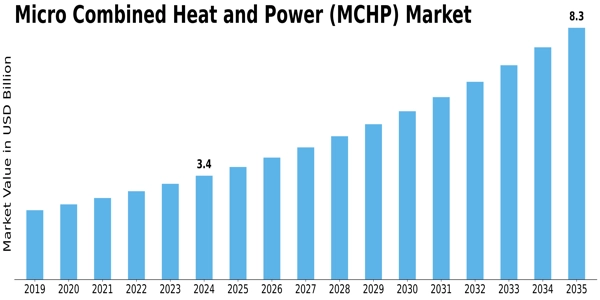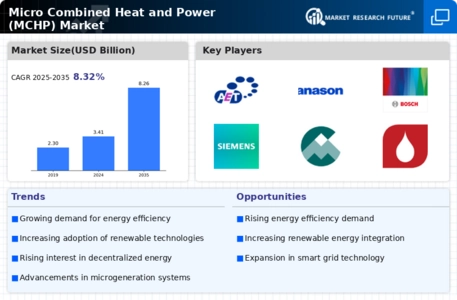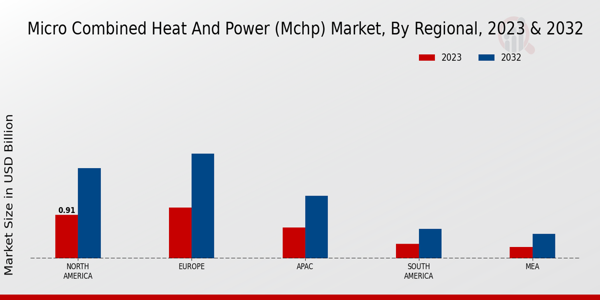-
EXECUTIVE SUMMARY
-
Key Findings
-
Market Segmentation
-
Challenges and Opportunities
-
Future
-
MARKET INTRODUCTION
-
Definition
-
Scope of the study
- Research Objective
- Assumption
- Limitations
-
RESEARCH METHODOLOGY
-
Overview
-
Secondary Research
-
Primary Research
- Breakdown of Primary
-
Forecasting Model
-
Market Size Estimation
- Top-Down Approach
-
Data Triangulation
-
Validation
-
MARKET DYNAMICS
-
Overview
-
Drivers
-
Restraints
-
Opportunities
-
MARKET
-
Value chain Analysis
-
Porter's Five Forces
- Bargaining Power of Suppliers
- Bargaining Power
- Threat of New Entrants
- Threat of Substitutes
- Intensity of Rivalry
-
COVID-19 Impact Analysis
- Regional Impact
- Opportunity and
-
MICRO COMBINED HEAT AND POWER (MCHP)
-
Internal Combustion Engine
-
Fuel Cell
-
MICRO COMBINED HEAT AND POWER (MCHP)
-
Natural Gas
-
Biogas
-
Propane
-
Renewable Energy
-
MICRO COMBINED HEAT AND POWER
-
Residential
-
Commercial
-
Industrial
-
MICRO COMBINED HEAT AND POWER (MCHP) MARKET, BY END
-
Heating
-
Electricity Generation
-
MICRO COMBINED HEAT AND POWER (MCHP) MARKET,
-
North America
- US
-
Europe
- Germany
- UK
- France
- Russia
- Italy
- Spain
- Rest
-
APAC
- China
- India
- South Korea
- Malaysia
- Thailand
- Indonesia
- Rest of APAC
-
South America
- Mexico
- Argentina
- Rest of South
-
MEA
- GCC Countries
- South Africa
- Rest of MEA
-
COMPETITIVE LANDSCAPE
-
Competitive Analysis
-
Market share Analysis
-
Major Growth Strategy in the Micro Combined Heat and Power (MCHP) Market
-
Competitive Benchmarking
-
Leading Players in Terms of Number
-
Key
- New Product Launch/Service Deployment
- Merger & Acquisitions
- Joint Ventures
- Sales and Operating Income
-
COMPANY PROFILES
-
Aalborg
- Financial Overview
- Products Offered
- Key Developments
- SWOT Analysis
- Key Strategies
-
Panasonic
- Financial Overview
- Products Offered
- Key Developments
- SWOT Analysis
- Key Strategies
-
Bosch
- Financial Overview
- Products Offered
- Key Developments
- SWOT Analysis
- Key Strategies
-
Siemens
- Financial Overview
- Products Offered
- Key Developments
- SWOT Analysis
- Key Strategies
-
Ceres Media
- Financial Overview
- Products
- Key Developments
- SWOT Analysis
-
Lifestream
- Financial Overview
- Key Developments
- SWOT Analysis
- Key Strategies
-
Sener
- Financial Overview
- Products Offered
- Key Developments
- SWOT Analysis
- Key Strategies
-
E.ON
- Financial Overview
- Products Offered
- Key Developments
- SWOT Analysis
- Key Strategies
-
Viessmann
- Financial Overview
- Products Offered
- Key Developments
- SWOT
- Key Strategies
-
ENGIE
- Financial
- Products Offered
- Key Developments
- Key Strategies
-
Catalyst Energy
- Products Offered
- Key Developments
- SWOT Analysis
- Key Strategies
-
Qnergy
- Financial Overview
- Products Offered
- Key
- SWOT Analysis
- Key Strategies
- Financial Overview
- Products Offered
- Key Developments
- SWOT Analysis
- Key
-
MGT Power
- Financial Overview
- Key Developments
- SWOT Analysis
- Key Strategies
-
Vaillant
- Financial Overview
- Products Offered
- Key Developments
- SWOT
- Key Strategies
-
APPENDIX
-
References
-
Related Reports
-
LIST OF ASSUMPTIONS
-
NORTH AMERICA MICRO COMBINED HEAT AND POWER (MCHP) MARKET SIZE ESTIMATES
-
NORTH AMERICA
-
NORTH AMERICA MICRO COMBINED HEAT
-
NORTH AMERICA MICRO COMBINED HEAT AND POWER (MCHP)
-
NORTH AMERICA MICRO COMBINED HEAT AND POWER (MCHP) MARKET SIZE ESTIMATES &
-
US MICRO COMBINED
-
US MICRO COMBINED HEAT AND POWER (MCHP) MARKET SIZE
-
US MICRO COMBINED HEAT AND
-
US MICRO COMBINED HEAT AND POWER (MCHP) MARKET SIZE ESTIMATES &
-
CANADA MICRO COMBINED
-
CANADA MICRO COMBINED HEAT AND POWER (MCHP) MARKET
-
CANADA MICRO COMBINED HEAT AND POWER (MCHP) MARKET SIZE ESTIMATES & FORECAST,
-
CANADA MICRO COMBINED HEAT
-
CANADA MICRO COMBINED HEAT AND POWER (MCHP) MARKET SIZE
-
EUROPE MICRO COMBINED HEAT
-
EUROPE MICRO COMBINED HEAT AND POWER (MCHP) MARKET SIZE
-
EUROPE MICRO COMBINED HEAT
-
GERMANY MICRO COMBINED HEAT AND POWER (MCHP) MARKET SIZE
-
GERMANY MICRO COMBINED HEAT
-
GERMANY MICRO COMBINED HEAT AND POWER (MCHP) MARKET
-
GERMANY MICRO COMBINED HEAT AND POWER (MCHP) MARKET SIZE ESTIMATES & FORECAST,
-
UK MICRO COMBINED HEAT AND
-
UK MICRO COMBINED HEAT AND POWER (MCHP) MARKET SIZE ESTIMATES
-
UK MICRO
-
UK MICRO COMBINED HEAT AND POWER (MCHP)
-
UK MICRO COMBINED HEAT AND POWER (MCHP) MARKET SIZE ESTIMATES & FORECAST,
-
FRANCE MICRO COMBINED HEAT
-
FRANCE MICRO COMBINED HEAT AND POWER (MCHP) MARKET
-
FRANCE MICRO COMBINED HEAT AND POWER (MCHP) MARKET SIZE ESTIMATES & FORECAST,
-
FRANCE MICRO COMBINED HEAT
-
FRANCE MICRO COMBINED HEAT AND POWER (MCHP) MARKET SIZE
-
RUSSIA MICRO COMBINED HEAT
-
RUSSIA MICRO COMBINED HEAT AND POWER (MCHP) MARKET SIZE
-
RUSSIA MICRO COMBINED HEAT
-
ITALY MICRO COMBINED HEAT AND POWER (MCHP) MARKET SIZE
-
ITALY MICRO COMBINED HEAT
-
ITALY MICRO COMBINED HEAT AND POWER (MCHP) MARKET
-
ITALY MICRO COMBINED HEAT AND POWER (MCHP) MARKET SIZE ESTIMATES & FORECAST,
-
SPAIN MICRO COMBINED HEAT
-
SPAIN MICRO COMBINED HEAT AND POWER (MCHP) MARKET
-
SPAIN MICRO COMBINED HEAT AND POWER (MCHP) MARKET SIZE ESTIMATES & FORECAST,
-
SPAIN MICRO COMBINED HEAT
-
SPAIN MICRO COMBINED HEAT AND POWER (MCHP) MARKET SIZE
-
REST OF EUROPE
-
REST OF EUROPE MICRO COMBINED HEAT
-
REST OF EUROPE MICRO COMBINED HEAT AND POWER (MCHP)
-
REST OF EUROPE MICRO COMBINED HEAT AND POWER (MCHP) MARKET SIZE ESTIMATES &
-
APAC MICRO COMBINED
-
APAC MICRO COMBINED HEAT AND POWER (MCHP) MARKET
-
APAC MICRO COMBINED HEAT AND POWER (MCHP) MARKET SIZE ESTIMATES & FORECAST,
-
APAC MICRO COMBINED HEAT
-
APAC MICRO COMBINED HEAT AND POWER (MCHP) MARKET SIZE
-
CHINA MICRO COMBINED HEAT
-
CHINA MICRO COMBINED HEAT AND POWER (MCHP) MARKET SIZE
-
CHINA MICRO COMBINED HEAT AND
-
INDIA MICRO COMBINED HEAT AND POWER (MCHP) MARKET SIZE ESTIMATES
-
INDIA MICRO
-
INDIA MICRO COMBINED HEAT AND POWER (MCHP)
-
INDIA MICRO COMBINED HEAT AND POWER (MCHP) MARKET SIZE ESTIMATES &
-
INDIA MICRO COMBINED
-
JAPAN MICRO COMBINED HEAT AND POWER (MCHP) MARKET
-
JAPAN MICRO COMBINED HEAT AND POWER (MCHP) MARKET SIZE ESTIMATES & FORECAST,
-
JAPAN MICRO COMBINED HEAT
-
JAPAN MICRO COMBINED HEAT AND POWER (MCHP) MARKET
-
JAPAN MICRO COMBINED HEAT AND POWER (MCHP) MARKET SIZE ESTIMATES & FORECAST,
-
SOUTH KOREA MICRO COMBINED
-
SOUTH KOREA MICRO COMBINED HEAT AND POWER (MCHP)
-
SOUTH KOREA MICRO COMBINED HEAT AND POWER (MCHP) MARKET SIZE ESTIMATES
-
SOUTH KOREA
-
SOUTH KOREA MICRO COMBINED HEAT AND
-
MALAYSIA MICRO COMBINED HEAT AND POWER (MCHP) MARKET SIZE ESTIMATES
-
MALAYSIA
-
MALAYSIA MICRO COMBINED HEAT AND
-
MALAYSIA MICRO COMBINED HEAT AND POWER (MCHP) MARKET SIZE
-
MALAYSIA
-
THAILAND MICRO COMBINED HEAT AND POWER
-
THAILAND MICRO COMBINED HEAT AND POWER (MCHP) MARKET SIZE ESTIMATES
-
THAILAND
-
THAILAND MICRO COMBINED HEAT AND POWER
-
THAILAND MICRO COMBINED HEAT AND POWER (MCHP) MARKET SIZE ESTIMATES
-
INDONESIA
-
INDONESIA MICRO COMBINED HEAT AND POWER
-
INDONESIA MICRO COMBINED HEAT AND POWER (MCHP) MARKET SIZE ESTIMATES
-
INDONESIA
-
INDONESIA MICRO COMBINED HEAT AND
-
REST OF APAC MICRO COMBINED HEAT AND POWER (MCHP) MARKET SIZE ESTIMATES
-
REST OF
-
REST OF APAC MICRO COMBINED
-
REST OF APAC MICRO COMBINED HEAT AND POWER (MCHP)
-
REST OF APAC MICRO COMBINED HEAT AND POWER (MCHP) MARKET SIZE ESTIMATES &
-
SOUTH AMERICA MICRO
-
SOUTH AMERICA MICRO COMBINED HEAT AND
-
SOUTH AMERICA MICRO COMBINED HEAT AND POWER (MCHP) MARKET
-
SOUTH AMERICA MICRO COMBINED HEAT AND POWER (MCHP) MARKET SIZE ESTIMATES &
-
SOUTH AMERICA MICRO
-
BRAZIL MICRO COMBINED HEAT AND POWER (MCHP)
-
BRAZIL MICRO COMBINED HEAT AND POWER (MCHP) MARKET SIZE ESTIMATES &
-
BRAZIL MICRO COMBINED
-
BRAZIL MICRO COMBINED HEAT AND POWER (MCHP) MARKET
-
BRAZIL MICRO COMBINED HEAT AND POWER (MCHP) MARKET SIZE ESTIMATES & FORECAST,
-
MEXICO MICRO COMBINED HEAT
-
MEXICO MICRO COMBINED HEAT AND POWER (MCHP) MARKET
-
MEXICO MICRO COMBINED HEAT AND POWER (MCHP) MARKET SIZE ESTIMATES & FORECAST,
-
MEXICO MICRO COMBINED
-
MEXICO MICRO COMBINED HEAT AND POWER (MCHP) MARKET
-
ARGENTINA MICRO COMBINED HEAT AND POWER (MCHP) MARKET SIZE ESTIMATES &
-
ARGENTINA MICRO
-
ARGENTINA MICRO COMBINED HEAT AND POWER
-
ARGENTINA MICRO COMBINED HEAT AND POWER (MCHP) MARKET SIZE ESTIMATES
-
ARGENTINA
-
REST OF SOUTH AMERICA MICRO COMBINED HEAT
-
REST OF SOUTH AMERICA MICRO COMBINED HEAT AND POWER
-
REST OF SOUTH AMERICA MICRO COMBINED HEAT AND POWER (MCHP) MARKET
-
REST OF SOUTH AMERICA MICRO COMBINED HEAT AND POWER (MCHP) MARKET SIZE ESTIMATES
-
REST OF SOUTH
-
MEA MICRO COMBINED HEAT AND
-
MEA MICRO COMBINED HEAT AND POWER (MCHP) MARKET SIZE
-
MEA MICRO COMBINED HEAT AND
-
MEA MICRO COMBINED HEAT AND POWER (MCHP) MARKET SIZE ESTIMATES
-
GCC COUNTRIES
-
GCC COUNTRIES MICRO COMBINED HEAT AND
-
GCC COUNTRIES MICRO COMBINED HEAT AND POWER (MCHP) MARKET
-
GCC COUNTRIES MICRO COMBINED HEAT AND POWER (MCHP) MARKET SIZE ESTIMATES &
-
GCC COUNTRIES MICRO
-
SOUTH AFRICA MICRO COMBINED HEAT AND POWER
-
SOUTH AFRICA MICRO COMBINED HEAT AND POWER (MCHP) MARKET SIZE ESTIMATES
-
SOUTH AFRICA
-
SOUTH AFRICA MICRO COMBINED HEAT AND POWER
-
SOUTH AFRICA MICRO COMBINED HEAT AND POWER (MCHP) MARKET SIZE ESTIMATES
-
REST OF MEA
-
REST OF MEA MICRO COMBINED HEAT AND POWER
-
REST OF MEA MICRO COMBINED HEAT AND POWER (MCHP) MARKET SIZE ESTIMATES
-
REST OF
-
REST OF MEA MICRO COMBINED HEAT
-
PRODUCT LAUNCH/PRODUCT DEVELOPMENT/APPROVAL
-
ACQUISITION/PARTNERSHIP
-
NORTH AMERICA MICRO COMBINED HEAT AND POWER (MCHP)
-
US MICRO COMBINED HEAT AND POWER (MCHP) MARKET ANALYSIS
-
US MICRO COMBINED HEAT AND POWER (MCHP) MARKET ANALYSIS
-
US MICRO COMBINED HEAT AND POWER (MCHP) MARKET ANALYSIS
-
US MICRO COMBINED HEAT AND POWER (MCHP) MARKET ANALYSIS
-
US MICRO COMBINED HEAT AND POWER (MCHP) MARKET ANALYSIS
-
CANADA MICRO COMBINED HEAT AND POWER (MCHP) MARKET ANALYSIS
-
CANADA MICRO COMBINED HEAT AND POWER (MCHP) MARKET
-
CANADA MICRO COMBINED HEAT AND POWER (MCHP)
-
CANADA MICRO COMBINED HEAT AND POWER
-
CANADA MICRO COMBINED HEAT AND
-
EUROPE MICRO COMBINED
-
GERMANY MICRO COMBINED HEAT
-
GERMANY MICRO COMBINED
-
GERMANY MICRO
-
GERMANY
-
UK MICRO COMBINED HEAT AND POWER (MCHP) MARKET ANALYSIS BY TECHNOLOGY
-
UK MICRO COMBINED HEAT AND POWER (MCHP) MARKET ANALYSIS BY FUEL TYPE
-
UK MICRO COMBINED HEAT AND POWER (MCHP) MARKET ANALYSIS BY APPLICATION
-
UK MICRO COMBINED HEAT AND POWER (MCHP) MARKET ANALYSIS BY END USE
-
UK MICRO COMBINED HEAT AND POWER (MCHP) MARKET ANALYSIS BY REGIONAL
-
FRANCE MICRO COMBINED HEAT AND POWER (MCHP) MARKET ANALYSIS BY TECHNOLOGY
-
FRANCE MICRO COMBINED HEAT AND POWER (MCHP) MARKET ANALYSIS BY FUEL
-
FRANCE MICRO COMBINED HEAT AND POWER (MCHP) MARKET ANALYSIS
-
FRANCE MICRO COMBINED HEAT AND POWER (MCHP) MARKET
-
FRANCE MICRO COMBINED HEAT AND POWER (MCHP)
-
RUSSIA MICRO COMBINED HEAT AND POWER
-
RUSSIA MICRO COMBINED HEAT
-
RUSSIA MICRO COMBINED
-
RUSSIA MICRO
-
RUSSIA
-
ITALY MICRO COMBINED HEAT AND POWER (MCHP) MARKET ANALYSIS BY FUEL TYPE
-
ITALY MICRO COMBINED HEAT AND POWER (MCHP) MARKET ANALYSIS BY APPLICATION
-
ITALY MICRO COMBINED HEAT AND POWER (MCHP) MARKET ANALYSIS BY END
-
ITALY MICRO COMBINED HEAT AND POWER (MCHP) MARKET ANALYSIS
-
SPAIN MICRO COMBINED HEAT AND POWER (MCHP) MARKET ANALYSIS
-
SPAIN MICRO COMBINED HEAT AND POWER (MCHP) MARKET
-
SPAIN MICRO COMBINED HEAT AND POWER (MCHP)
-
SPAIN MICRO COMBINED HEAT AND POWER
-
SPAIN MICRO COMBINED HEAT AND
-
REST OF EUROPE MICRO COMBINED
-
REST OF EUROPE
-
REST OF EUROPE MICRO COMBINED HEAT AND POWER (MCHP) MARKET ANALYSIS
-
REST OF EUROPE MICRO COMBINED HEAT AND POWER (MCHP)
-
APAC MICRO COMBINED HEAT AND POWER
-
CHINA MICRO COMBINED HEAT AND POWER (MCHP)
-
CHINA MICRO COMBINED HEAT AND POWER
-
CHINA MICRO COMBINED HEAT AND
-
CHINA MICRO COMBINED
-
CHINA MICRO COMBINED
-
INDIA MICRO COMBINED
-
INDIA MICRO
-
INDIA
-
INDIA MICRO COMBINED HEAT AND POWER (MCHP) MARKET ANALYSIS BY END USE
-
INDIA MICRO COMBINED HEAT AND POWER (MCHP) MARKET ANALYSIS BY REGIONAL
-
JAPAN MICRO COMBINED HEAT AND POWER (MCHP) MARKET ANALYSIS BY TECHNOLOGY
-
JAPAN MICRO COMBINED HEAT AND POWER (MCHP) MARKET ANALYSIS BY FUEL
-
JAPAN MICRO COMBINED HEAT AND POWER (MCHP) MARKET ANALYSIS
-
JAPAN MICRO COMBINED HEAT AND POWER (MCHP) MARKET
-
JAPAN MICRO COMBINED HEAT AND POWER (MCHP)
-
SOUTH KOREA MICRO COMBINED HEAT AND
-
SOUTH KOREA MICRO COMBINED
-
SOUTH KOREA

















Leave a Comment